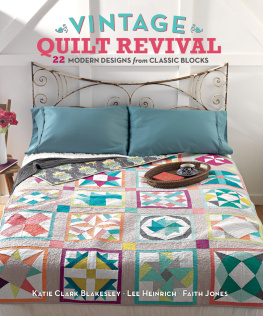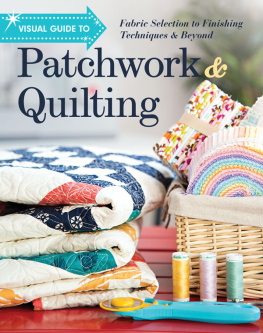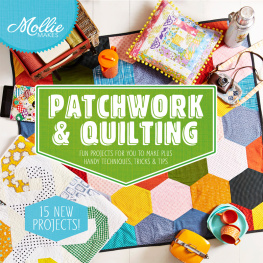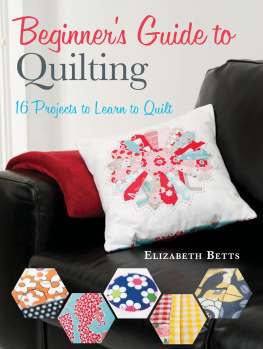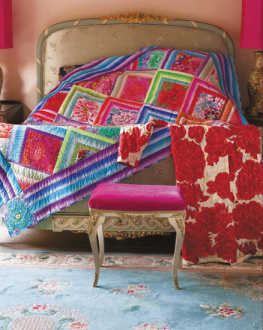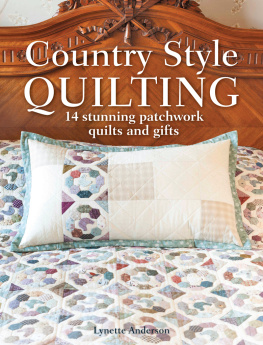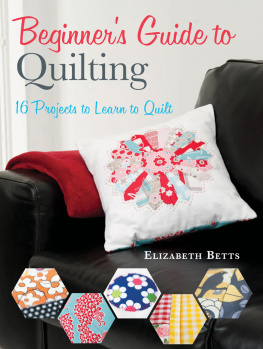VINTAGE
QUILT REVIVAL
MODERN DESIGNS from CLASSIC BLOCKS

K ATIE C LARK B LAKESLEY L EE H EINRICH F AITH J ONES


INTRODUCTION
We three authors feel fortunate to have personal connections with the quilts of the past. As a child, Katie was surrounded by beautiful quilts that were handmade by her grandmother, great-grandmothers, and great-great-grandmothers. When she visited her grandmothers home, the beds always had special quilts on them. Lee spent her childhood sleeping under an antique quilt that had been made by her great-grandmother and the women of a rural Depression-era quilting bee. That quilt was on Lees bed for years and still has a special place in her heart. Faiths childhood memories include many visits to local antiques shops, as her mother searched for and collected handmade quilts from past generations. These antique quilts were always stacked and draped in rooms throughout the house. None of the three of us gave much thought to becoming quilters until we were well into adulthood, but vintage quilts and the women who made them played a role in our lives from the beginning.
Our paths may be somewhat uniquenot everyone is lucky enough to have a family heritage of quilting. But the end result for all of us is the same: We love the creative process that starts with a pile of beautiful fabric and ends in a unique handmade quilt. As the three of us continued to search for inspiration in new and different places, we were drawn to the quilts of our heritagethe quilts of the past.
In the summer of 2011, the three of us joined together to host on our blogs a series of online tutorials based on vintage quilt blocks. For the Summer Sampler Series, we each chose four blocks from Barbara Brackmans Encyclopedia of Pieced Quilt Patterns and provided step-by-step instructions, foundation-piecing templates, technique tutorials, and even a bit of the history behind the blocks.
We finished the series determined to learn more about traditional piecing and vintage quilts and were pleased to realize that a number of vintage quilts, especially many made in the nineteenth and early twentieth centuries, fit the current working definition of modern quilting. Modern quilting typically includes at least one of the following: improvisational piecing; asymmetrical design; simplicity instead of fussiness; on-trend color combinations (often including the use of solids); utilitarian use and design; and reference to nature, architecture, and modern art as sources of inspiration.
More and more frequently, quilters of all backgrounds have become interested in traditional-to-modern quilting, led by pioneers such as Denyse Schmidt. Quilters looking for a new muse and seeking to improve their techniques are starting to discover and recognize traditional patterns as a treasure trove of inspiration. Likewise, many quilters from a more traditional background are becoming interested in aspects of modern quilting and how to blend elements of each into a single project.
Vintage Quilt Revival invites readers to use vintage quilt blocks to create unique works of art. In our book, you will find step-by-step instructions for making twenty traditional quilt blocks, along with a complete project and three sampler quilts using each of these blocks, as well as mini history lessons and design tips for making traditional blocks fresh and modern for the twenty-first century. We also offer brief tutorials on the basics of some important techniques, including foundation piecing, to help you along your way.

Spin It Again Quilt, made by Lee Heinrich ()
Unlike our original Summer Sampler Series, our emphasis here is not on the sampler quilt itselfalthough we do include instructions for three unique sampler quilts using the blocks in this book. Instead, our focus is to provide you with fresh quilt layouts, simple and detailed instructions, and solid strategies for using vintage blocks in new and original ways.
We hope Vintage Quilt Revival inspires you to improve your sewing skills and to try a new technique. If you are a beginning quilter or are new to foundation piecing, just take things step by step. Cut a sample block and piece it together before cutting out all of your fabric, or you may have to re-cut (something that has happened to us more than once). Although there are some quicker small-scale projects and quilts in this book, we hope you will enjoy working on some of these quilts over weeks or even months, and that you will enjoy not only the end product, but the process as well. Rememberthere is something inherently beautiful in the imperfection of a handmade item. Embrace the skill-building moments as they come.

Double Dutch Table Runner, made by Katie Clark Blakesley ()
We believe that learning the history of our craft and something of the quilters before us makes us better-informed and more innovative quilters. We hope you will be inspired to learn more about vintage quilts (and the quilters who made them) and will visit a local textile or folk art museum. Whether you decide to create a nontraditional block repeat, include more negative space in a quilt design, use multiple blocks to create unique secondary patterns, or vary the size of your blocks, our goal is to provide examples and tools that we hope will encourage you to make quilts that fit into the burgeoning traditional-made-modern movement.



2O CLASSIC BLOCKS

Sampler Quit, on-Point, made by Faith Jones ()

Double Z
(Geometric Slide Quilt, )

Dakota Star
(Stardust Quilt, )

Riviera
(Stardust Quilt, )


